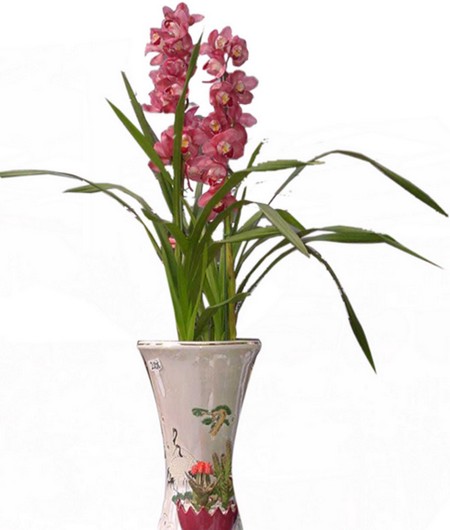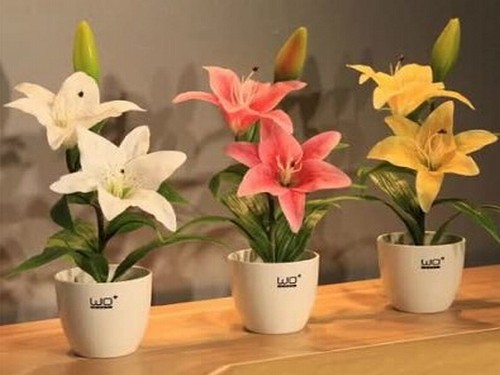Daily maintenance and management methods of lily bonsai
The lilies are used for viewing, especially the cut flowers from the Netherlands and Japan. The bulbs of lilies are rich in starch, and some of them can be eaten as vegetables. In China, eating lilies has a long history, and traditional Chinese medicine believes that lilies are slightly cold and flat, with the effects of moistening the lungs and relieving cough, clearing fire, calming the heart and mind, and the flower bulbs can be used as medicine. It is a kind of flower for both medicine and food.
The lily is known as "the fairy of cloud clothes". Because of its elegant and pure appearance, Catholicism uses the white lily as the symbol of the Virgin Mary, while the Vatican takes the lily as the national flower. The seed heads of lilies are made of scales, taking the meaning of "a hundred years of harmony" and "Pepsi agreement". Since ancient times, China has been regarded as an indispensable auspicious flower for weddings. So, how do we carry out maintenance management on a daily basis?
1. Lighting management
Lily likes the environment with plenty of light. Lack of light is easy to cause overgrowth of plants and poor flowering, but it is not suitable for direct light. The potted lilies needed by the winter Spring Festival market should choose sunshine-neutral varieties and supplement light properly to make them grow better, dwarf plants, bright flowers and thick green leaves. In spring, summer and autumn, shade nets should be used for proper shading.
2. Temperature management
Lily likes a cool climate, and the suitable temperature for growth is 10 Mel 25 ℃. However, from planting to pre-emergence, it is appropriate to keep the low temperature no more than 12 ℃ 13 Mel. After emergence, the temperature should be raised properly and the temperature should be controlled at about 22 ℃ in the daytime. If necessary, measures can be taken to heat up properly in winter. Different kinds of lilies require different temperatures at night, so they should be treated differently and placed separately.
3. Water management
Lily's growth period and flowering period need more water, it is appropriate to keep the basin soil moist, but not too wet, avoid stagnant water, in order to prevent rotting roots and diseases. If the air is too dry, you can sprinkle water on the leaf surface and the ground to keep the air relative humidity at about 70%.
4. Fertilizer management
The lily grew from small seedlings, began to be topdressing when the upper leaves of the stem had been expanded, soil application was combined with foliar fertilization, 10-Mel was applied once every 15 days, thin fertilizer was applied frequently, heavy fertilizer was avoided, nitrogen fertilizer was the main fertilizer in the early stage, phosphorus and potassium fertilizer was the main fertilizer in the late bud.
5. Dwarfing treatment
When high 6--10cm was unearthed from lily buds, paclobutrazol of 100--150mg/L was applied to the soil to control the height of lily plants, so as to achieve the purpose of dwarfing plants, compact plant shape and improving ornamental value.
6. Pest control
The prevention and control of diseases and insect pests of lilies should give priority to prevention. The main diseases are Botrytis cinerea, root rot, bulb rot, leaf blight and so on. Disease control methods include: selecting disease-free bulbs; disinfecting and sterilizing bulbs, substrates and flowerpots before planting; maintaining ambient air circulation and moderate humidity; timely removal and destruction of diseased plants to prevent infection; regular chemical control. The methods of pest control are as follows: timely removal of weeds in and around the basin; keeping the environment clean and tidy; spraying with chemicals if necessary.
Commonly used agents are: carbendazim, chlorothalonil, methyl thiophanate, dimethoate emulsion, deltamethrin and so on. Read the instruction manual carefully before using it.
Time: 2019-06-02 Click:
- Prev

Leaf treatment in the maintenance of potted Flowers
If potted plants are not properly managed, their leaves will turn yellow, scorched and curled. The change of the blade can be used as the basis for analyzing the problems existing in the maintenance work, and corresponding measures can be taken accordingly. The conservation of potted flowers: leaf treatment. 1. The young leaves turn yellow, or the lower leaves curl and wither
- Next

Culture methods and matters needing attention of perfume lily
Perfume lilies have always been regarded as the queen of lilies, and the petals do not have any spotted impurities, which are very good-looking, and the light fragrance of perfume lilies is very suitable to be used in the layout of the home environment. The following editor will talk to you about perfume lily culture methods and matters needing attention.
Related
- Fuxing push coffee new agricultural production and marketing class: lack of small-scale processing plants
- Jujube rice field leisure farm deep ploughing Yilan for five years to create a space for organic food and play
- Nongyu Farm-A trial of organic papaya for brave women with advanced technology
- Four points for attention in the prevention and control of diseases and insect pests of edible fungi
- How to add nutrient solution to Edible Fungi
- Is there any good way to control edible fungus mites?
- Open Inoculation Technology of Edible Fungi
- Is there any clever way to use fertilizer for edible fungus in winter?
- What agents are used to kill the pathogens of edible fungi in the mushroom shed?
- Rapid drying of Edible Fungi

